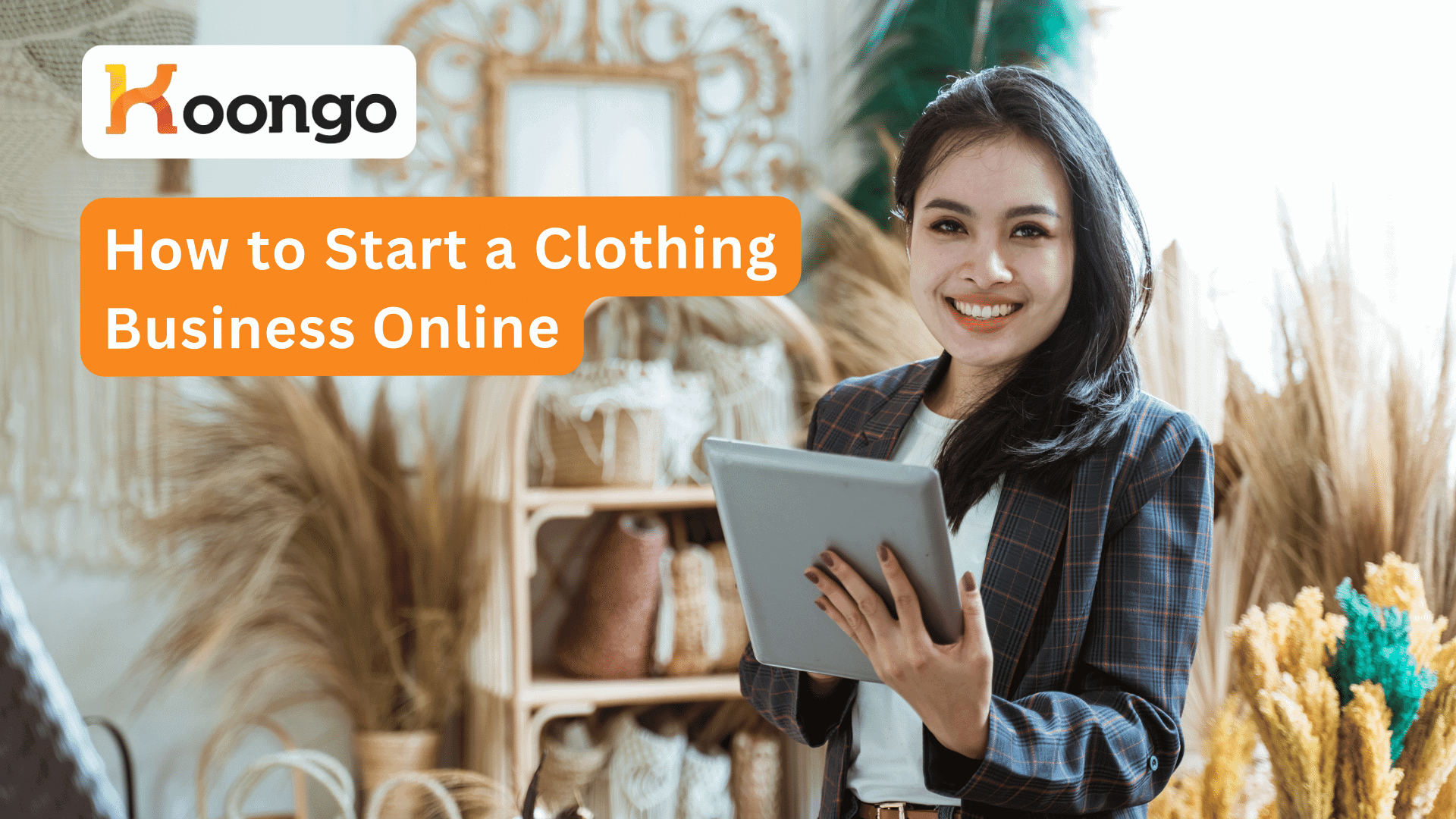Are you passionate about fashion and dream of running your online clothing store? With the right approach and a little creativity, you can turn that dream into reality! In this step-by-step guide on how to start an online clothing business, we’ll walk you through the entire process, from selecting your clothing niche to marketing your brand and managing operations.
By the end of this blog post, you’ll have a clear understanding of what it takes to create a successful online clothing store and the confidence to take the first steps towards launching your fashion empire.
Jump ahead to
Key Takeaways
Choose a unique clothing niche that aligns with your business goals
Pick the right ecommerce platform & craft an inspiring brand identity
Motivate customers and emphasize operations/service for success!
Choosing Your Clothing Niche

The first step to start selling clothes online and launching your own clothing store is choosing a niche. This involves focusing on specific demographics, personal interests, and market gaps to create a unique and targeted brand. A well-defined niche can set you apart from the competition and help you build customer loyalty.
When selecting a niche, consider your interests and passions, as well as any potential market gaps or target demographics. For example, if you’re passionate about sustainable fashion, you could create a clothing line that uses eco-friendly materials and targets environmentally conscious consumers.
Having determined your niche, it’s now time to start crafting your unique designs. Sketch out your vision to bring your ideas to life. Create digital mockups and collaborate with a designer or clothing manufacturer to make it a reality. With unique designs and a well-defined niche, you’ll be well on your way to creating a standout online clothing brand.
Keep in mind that your niche will significantly influence your clothing line business plan. Therefore, spend time evaluating your options and opt for one that aligns closely with your personal interests and business aspirations.
Deciding on Your Business Model

After deciding on your niche, the next step is to settle on a business model for your online apparel store. There are four main options to consider:
Clothing manufacturer
White labeling
Dropshipping
Private label
Each model has its advantages and disadvantages, so it’s essential to carefully evaluate each option before making a decision.
Clothing manufacturer business models offer complete control over the production process and the ability to customize products but require a large upfront investment and hands-on management. White labeling allows for customization and bulk ordering but also requires you to manage the production process and find reliable manufacturers. Dropshipping provides the ability to quickly adapt to changing styles with minimal investment, but lacks control over the production process and requires inventory management. Private-label clothing offers flexibility in batch size and sampling but requires you to handle fulfillment and inventory management yourself.
When selecting the ideal business model, consider factors such as your budget, the production process, and your target audience. By choosing a model that aligns with your goals and resources, you’ll be better equipped for success in the competitive world of online fashion.
Kickstart your clothing line by adhering to the steps outlined by Printify, encompassing design creation, product selection, and online store setup. With a solid business model in place and obtaining the necessary business license, you’ll be well on your way to launching your own successful online clothing business.
Selecting an Ecommerce Platform

With your niche and business model in place, the next step is to pick an ecommerce platform. This is where you’ll build and manage your store, so it’s important to choose a platform that offers the features and functionality you need.
Popular ecommerce platforms include Shopify, WooCommerce, and BigCommerce. Each platform has its own unique advantages, so consider factors such as ease of use, customization options, and scalability when making your decision.
There are two main types of ecommerce platforms: hosted and self-hosted. Hosted platforms like Shopify or BigCommerce provide users with hosting and limited control over their sites, while self-hosted platforms like PrestaShop offer full control but require you to set up your own hosting. Consider your technical expertise and the level of customization you desire when choosing between hosted and self-hosted platforms.
Choosing the appropriate ecommerce platform for your needs sets the foundation for a successful clothing store that can evolve alongside your business and its ecommerce website.
Creating Your Brand Identity
Establishing a robust brand identity is fundamental to the success of your online apparel store. Your brand identity is what sets you apart from the competition and helps customers remember and connect with your store.
To create a memorable brand identity, follow these steps:
Select a name that reflects your niche, design aesthetic, and business goals.
Design a logo that captures the essence of your brand and can be easily recognized by potential customers.
Keep your target market in mind when making these decisions, as a strong brand identity should resonate with your audience.
Establish a consistent visual and messaging style across your website, social media, and marketing materials. This will help reinforce your brand identity and make it easier for customers to recognize and remember your store.
Crafting a unique and memorable brand identity paves the way towards cultivating a loyal customer base and distinguishing yourself in the competitive realm of online fashion.
Building Your Online Store
Having established your brand identity, the subsequent step is constructing your online store. Start by choosing a domain name that reflects your brand name and business objectives. Make sure it’s easy to remember and use a domain checker to ensure it’s available.
Next, select a template for your online store. There are plenty of stunning ready-made store templates available for popular ecommerce platforms like WooCommerce and Hostinger Website Builder. Choose a template that aligns with your brand identity and can be easily customized to create a unique look for your store.
Customize your template using techniques like whitespace, color, and large images to create an engaging and visually appealing online store. Be sure to make your site user-friendly by incorporating easy navigation, effective search functions, and a smooth checkout process.
Create high-quality product pages with detailed descriptions and images that showcase your clothing items from all angles. This will help customers get a complete understanding of your products and encourage them to make a purchase.
A focus on design, user experience, and high-quality product pages will result in an online store that not only attracts customers but also encourages repeat visits.
Marketing Your Online Clothing Store
With your online store now active, the next task is to publicize your brand and draw in prospective customers. Leverage various marketing channels, such as:
Social media
Email marketing
Search engine optimization (SEO)
Fashion marketplaces like Miinto, Zalando, Spartoo, The Vintage Bar, and About You
Use platforms like Instagram and Pinterest to showcase your products and connect with your target audience. Collaborate with influencers to reach new customers and build brand awareness. Invest in paid advertising on social media platforms to target specific demographics and drive traffic to your online store.
Email marketing is another powerful tool for promoting your online clothing store. Send regular newsletters to inform customers about new products, promotions, and special offers. Be sure to optimize your website for search engines to improve its visibility and attract organic traffic.
In addition to traditional marketing channels, explore fashion marketplaces like:
to reach new customers and boost sales. Utilizing a diversified range of marketing strategies will aid in attracting and retaining customers, thereby expanding your online clothing venture.
You can effortlessly link your online store with the mentioned marketplaces by utilizing services such as Koongo. Koongo establishes a seamless connection between your store and the online marketplace, ensuring a bidirectional synchronization. This means your product data gets nearly real-time updates on the marketplace, while Koongo also retrieves your marketplace orders and integrates them into your store’s backend. As a result, you can conveniently manage all your orders within the marketplace’s backend system.
Managing Operations and Customer Service
As your online apparel store expands, effective operations management and exceptional customer service become increasingly important. This includes handling:
Inventory
Order fulfillment
Shipping
Returns
By streamlining these processes, you’ll create a positive shopping experience for your customers and build brand loyalty.
A well-designed website with easy navigation and an effective search function can significantly improve the user experience. Ensure your checkout process is smooth and hassle-free to minimize cart abandonment and encourage customers to complete their purchases.
When it comes to customer service, always be responsive and attentive to your customers’ needs. Provide multiple channels for customers to reach you, such as email, phone, and live chat. Be proactive in addressing any issues or concerns and offer solutions that satisfy your customers.
Consider using tools like a fashion boutique POS system to help manage your customer base and synchronize discounts and promotions across your online and brick-and-mortar channels. This will help you maintain a consistent customer experience and grow your business.
Emphasizing efficient operations and superior customer service will result in a prosperous online business, particularly for an online boutique that encourages repeat patronage as an online clothing store in the fashion business. To sell clothing effectively, it’s essential to focus on these key aspects.
Summary
Launching a successful online clothing store may seem daunting at first, but with the right guidance and determination, you can turn your passion for fashion into a thriving business. By carefully selecting your niche, choosing a suitable business model, and creating a unique brand identity, you’ll be well on your way to building an online store that stands out in the competitive world of fashion.
So, what are you waiting for? Take the first steps towards launching your online clothing store today and turn your dreams into a reality.
Frequently Asked Questions
How much does it cost to start a clothing business online?
Starting a clothing business online can be done for as little as $1,000 and up to $100,000, depending on how much you’re willing to invest in barriers to entry, mobility, and scalability.
How can I start selling clothes online from home?
Start your fashion business online by finding a niche, deciding what to sell, choosing a business model, planning your supply chain, creating your store, getting social, and implementing marketing and SEO strategies. Don’t forget about bookkeeping!
How to start a clothing brand online?
Start an online clothing store by choosing a niche, determining your business plan, selecting an ecommerce platform, picking a domain name, customizing your store with templates, listing products, and promoting the store.
How do I start a simple clothing business?
Start your clothing business by deciding on your niche, building a budget or business plan, organizing your business, creating designs, branding, manufacturing, testing the product, and finally launching it.
How much does it cost to start an online clothing store?
Starting an online clothing store can cost anywhere from free to up to $100,000, depending on the size of your business. Small businesses could invest from $1,000–10,000, while large businesses may need to spend $50,000–100,000. Make the right investments for your store today!
Continue reading →
 EN
EN 
